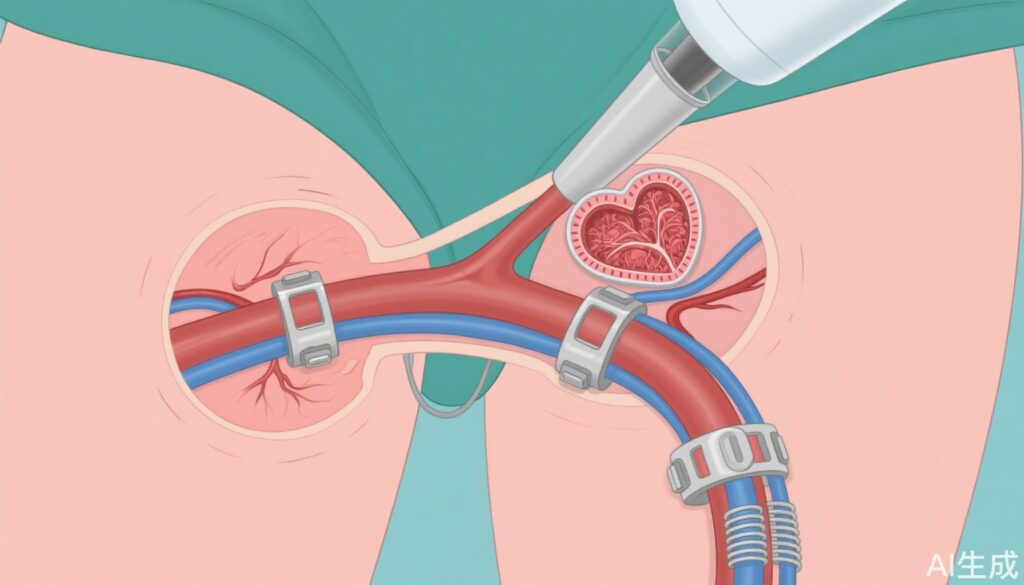Study Background and Disease Burden
Transfemoral transcatheter aortic valve implantation (TF-TAVI) is a widely adopted minimally invasive treatment for severe aortic stenosis, particularly in elderly or high-risk surgical patients. Despite marked advances, access site-related vascular complications remain an important cause of morbidity and mortality, affecting patient outcomes and healthcare resource utilization. Reliable and efficient vascular closure techniques are vital to minimizing bleeding and vascular complications following femoral artery access. Vascular closure devices (VCDs) employ either suture-based, plug-based, or combined mechanisms to achieve hemostasis. However, randomized data comparing various closure strategies remain scarce, limiting evidence-based decisions for optimal access management after TF-TAVI.
Study Design
Two key randomized trials evaluate different VCD strategies following TF-TAVI: the ACCESS-TAVI trial and the CHOICE-CLOSURE trial.
ACCESS-TAVI Trial
The ACCESS-TAVI trial is a prospective, multicenter, randomized study enrolling 454 patients undergoing TF-TAVI between September 2022 and April 2024. Participants were randomized to a combined suture-/plug-based VCD strategy (suture/plug group), which used one ProGlide™/ProStyle™ device (Abbott Vascular) plus one Angio-Seal® (Terumo), versus a suture-based VCD strategy (suture-only group) with two ProGlides™/ProStyles™. The primary endpoint was a composite of major or minor access site-related vascular complications assessed per Valve Academic Research Consortium (VARC) 3 criteria during index hospitalization. Secondary endpoints included time to hemostasis, bleeding classified ≥ type 2, and 30-day all-cause mortality.
CHOICE-CLOSURE Trial
The CHOICE-CLOSURE trial is a multicenter, investigator-initiated randomized clinical trial including 516 patients undergoing TF-TAVI. Patients were assigned to vascular access site closure using either a pure plug-based technique with the MANTA device (Teleflex) or a primary suture-based technique using ProGlide (Abbott Vascular), sometimes supplemented by a small plug. The primary endpoint comprised access site or access-related major and minor vascular complications during hospitalization, defined by VARC-2 criteria. Secondary endpoints assessed access site bleeding, device failures, and time to hemostasis.
Key Findings
The two trials reveal important differences regarding vascular closure strategy efficacy and safety.
ACCESS-TAVI: The combined suture-/plug-based group demonstrated a significantly lower composite rate of access site-related vascular complications (27%) compared with the suture-only group (54%), yielding a relative risk of 0.55 (95% CI, 0.44–0.68; P < 0.001). Time to hemostasis was shorter in the suture/plug group (mean 108 ± 208 seconds) than in the suture-only group (206 ± 171 seconds; P < 0.001). Furthermore, bleeding events classified as ≥ type 2 occurred less frequently in the combined group (6.2% vs. 12.1%, relative risk 0.66; P = 0.032). There was no significant difference in 30-day mortality.
CHOICE-CLOSURE: The pure plug-based group using MANTA experienced a higher rate of vascular complications (19.4%) versus the primary suture-based group (12.0%), with a relative risk of 1.61 (95% CI, 1.07–2.44; P = 0.029). Bleeding rates were numerically higher in the plug-based group (11.6% vs. 7.4%; P = 0.133), though device failure rates were comparable (4.7% vs. 5.4%; P = 0.841). Notably, the time to hemostasis was significantly shorter in the plug-based group (median 80 seconds) compared to the suture-based group (median 240 seconds; P < 0.001).
Comparative Analysis
Both studies underscore the trade-off between vascular complication rates and time to hemostasis based on closure strategy. The ACCESS-TAVI trial favors a combined suture-/plug-based approach (ProGlide + Angio-Seal), showing lower vascular complications and reduced bleeding compared to suture-only methods. Conversely, the CHOICE-CLOSURE trial finds that pure plug-based closure with MANTA leads to faster hemostasis but at the cost of higher complication rates compared with suture-based closure.
Importantly, the ACCESS-TAVI trial employed a hybrid device approach while CHOICE-CLOSURE contrasted plug-only to primarily suture-based closure. Differences in endpoints definitions (VARC-3 vs. VARC-2 criteria), study populations, and device combinations limit direct one-to-one comparisons. However, the evidence collectively suggests that combined closure techniques may optimize the balance between rapid hemostasis and reduced vascular complications.
Expert Commentary
Expert consensus emphasizes the importance of tailoring vascular closure strategies individually, considering vascular anatomy, patient bleeding risk, and operator expertise. While plug-based devices provide rapid closure suited for high-volume centers, the combined use of suture and plug devices may mitigate vascular adverse events. Current guidelines acknowledge the need for further high-quality randomized data to inform best practices.
Limitations in these studies include differing trial designs, device types, and endpoint criteria. Further research comparing standardized closure approaches would support more definitive clinical recommendations.
Conclusion
Randomized data from ACCESS-TAVI and CHOICE-CLOSURE trials provide valuable insights into vascular closure after TF-TAVI. The combined suture-/plug-based strategy demonstrated superiority over suture-only techniques in reducing vascular complications and bleeding without increasing mortality, while pure plug-based closure offered the fastest hemostasis but with relatively higher complication rates. These findings warrant individualized strategies balancing procedural efficiency with safety. Future studies should focus on refining device combinations and patient selection criteria to optimize TF-TAVI outcomes.
References
- Rheude T, Ruge H, Altaner N, et al. Comparison of strategies for vascular ACCESS closure after Transcatheter Aortic Valve Implantation: the ACCESS-TAVI randomized trial. Eur Heart J. 2025;46(7):635-645. doi: 10.1093/eurheartj/ehae784.
- Abdel-Wahab M, Hartung P, Dumpies O, et al; CHOICE-CLOSURE Investigators. Comparison of a Pure Plug-Based Versus a Primary Suture-Based Vascular Closure Device Strategy for Transfemoral Transcatheter Aortic Valve Replacement: The CHOICE-CLOSURE Randomized Clinical Trial. Circulation. 2022;145(3):170-183. doi: 10.1161/CIRCULATIONAHA.121.057856.



